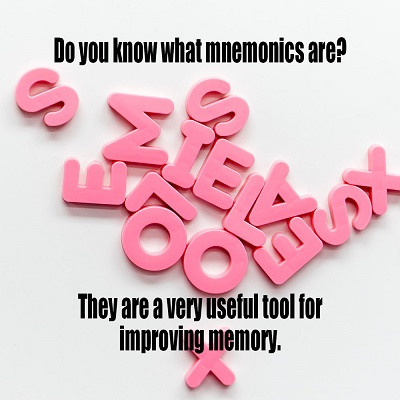 “Richard of York gave battle in vain.”
“Richard of York gave battle in vain.”
“Men very easily make jugs serve useful needs.”
Do these statements make sense? Probably not. But are they familiar? To many of us, they could be. Both sentences, no matter how nonsensical and confusing they may be, actually serve a bigger purpose than being coherent. They are good examples of how mnemonics are used.
Mnemonics are different techniques that help us retain and remember information. We all have probably used a mnemonic device at some point in our lives, especially as students. The fact that we all use different mnemonic devices is a testament that they do actually work.
Several mnemonic techniques have been popular over the years, and a lot of us don’t even realize that we are making use of these techniques in our everyday lives. We first learned them as children, and we continue making use of these techniques as adults.
Here are the different mnemonic devices that can help improve our memory.
Using Keywords
Several research studies have proved that using keywords and forming mental images using those keywords can improve our recall. This technique is especially useful when learning a new language.
Here’s how it works: For example, you need to remember that the Spanish word for pasture is pasto. Using keywords, you can think of a word that is similar to what you are trying to remember, such as the word pasta. Now imagine pasta growing out of a pasture.
By using this technique, you created a mental image (pasta growing out in a pasture) to help you remember the Spanish word for pasture, which is pasto.
Chunking and Organizing
This mnemonic device particularly works if you have to remember a large amount of information or a string of numbers, such as passwords, telephone numbers, or PINs.
In this technique, you simply chunk details into a smaller, more manageable string. For example, you need to memorize your ID number for easy reference. Instead of memorizing 1-0-6-2-4-3-1-7 as individual numbers, you can simply chunk two numbers together to make the sequence shorter. Therefore it becomes 10-62-43-17.
Using Songs
Do you know that the ABC song is simply a mnemonic device to help kids memorize the alphabet easier? The nursery rhyme “Twinkle, Twinkle Little Star” helped many of us learned the sequence of the alphabets. This is probably our first introduction to mnemonic devices.
One of the most successful ways to remember information is to put it in a song. But learning through songs is not just for children. Adults can also greatly benefit from this mnemonic device, as research showed that music can help people with mild cognitive impairment and Alzheimer’s disease.
Using Letters and Words
Do you still remember Richard Of York Gave Battle In Vain? It is actually a way to memorize the order of the colors of the rainbow – red (Richard), orange (Of), yellow (York), green (Gave), blue (Battle), indigo (In), violet (Vain).
The other statement, “Men very easily make jugs serve useful needs,” is a technique to help us remember the order of the planets in our solar system.
Using letters and words as a mnemonic device is a popular method, especially for students. So the next time you need to remember a sequence, maybe you can try coming up with your mnemonic sentence to help you remember.
Making Connections
Many of us constantly have a hard time recalling the names of people we have just met. One way to get past it is by making use of mental connections.
For example, you just met Emma. Instead of just remembering the name Emma (which you will likely forget), you can connect Emma to a trait of hers, such as energetic. Remembering “Energetic Emma” is more effective than simply recalling her name. Just don’t forget to leave off “energetic” the next time you call her!
Many different factors adversely affect our ability to recall information. However, there are also several ways to help us better recall things, which is empowering and strengthens our feelings of being in control. Mnemonic devices are proven effective techniques to help us out in different situations – from studying for a test or simply remembering the name of your new neighbor.






